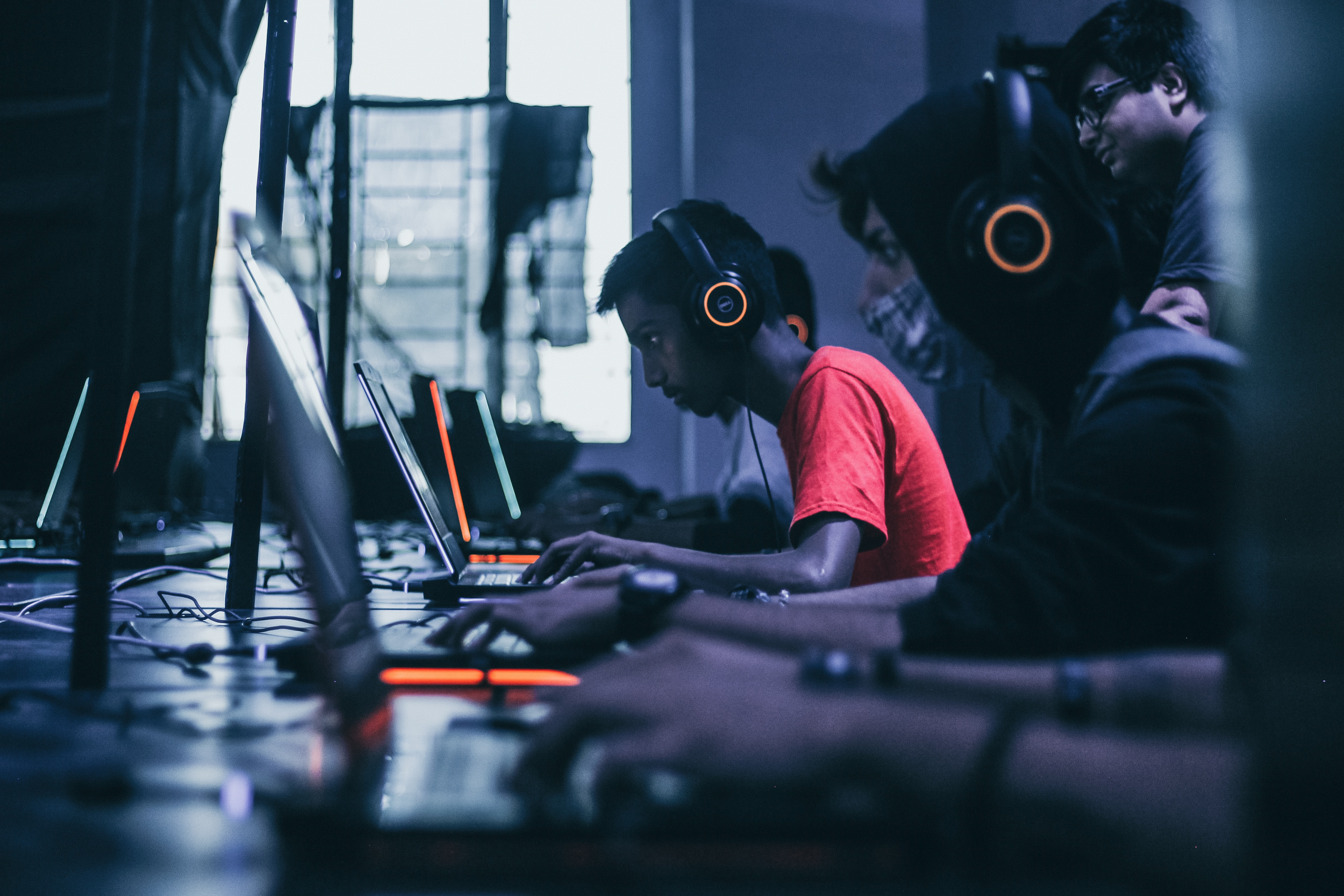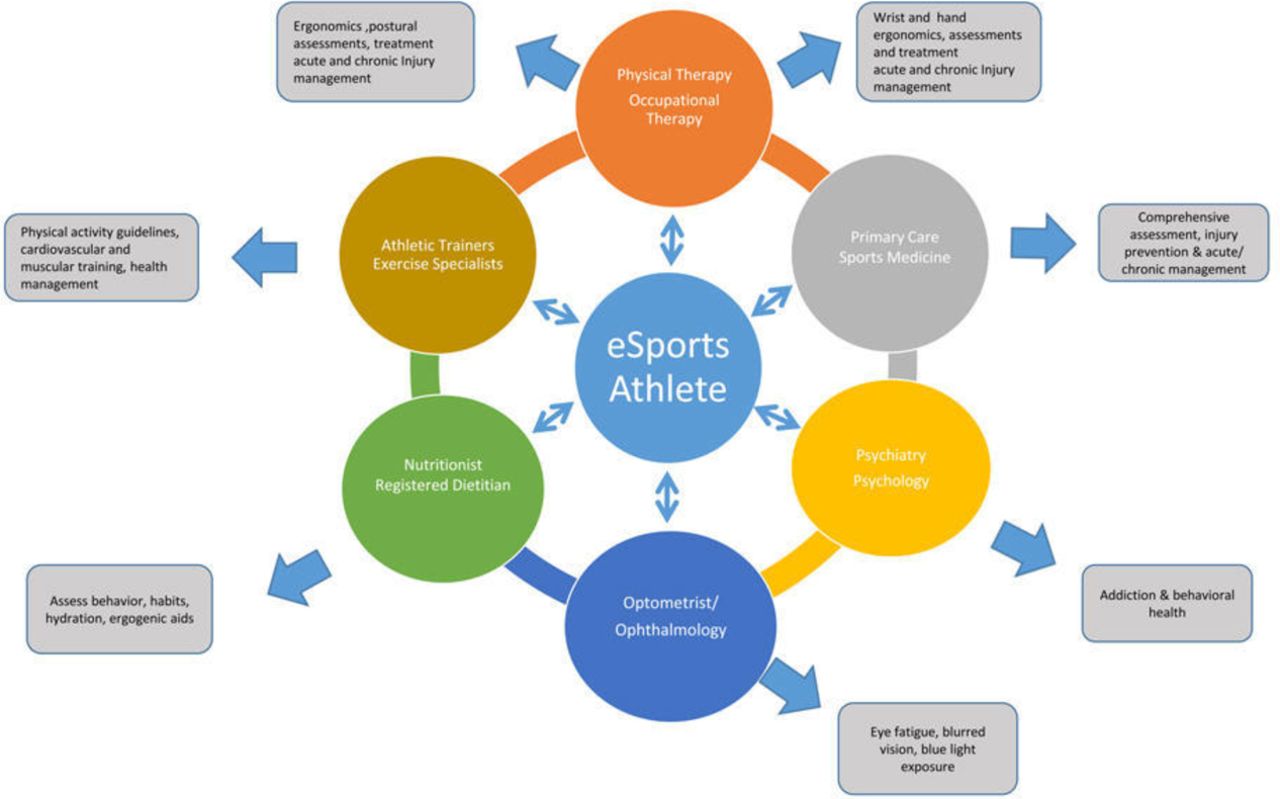
By Vincent Brinas, PT, DPT, Barnabas Health Ambulatory Care Center
Electronic competitive gaming (esports) is a popular form of sport involving electronic systems (PC or console) and a human-computer interface. Games such as League of Legends, Overwatch, Valorant and DOTA 2 have a global popularity with millions of gamers playing daily. Emerging are professional and competitive gamers who are considered top-tier in their respective ranks and compete seasonally in teams for upwards of millions of dollars. Professional leagues have sponsorships, training facilities and head coaches with the International Olympic Committee recognizing esports in 2017 with a speculative inclusion in the Paris 2024 Olympic Games. In the USA, esports players have been recognized as professional athletes since 2013 with universities across the country setting up varsity esports programs under the National Association of Collegiate Esports.
As athletes, players are involved with games that involve high cognitive demand and functional integration often performing more keystrokes per minute than the average gamer. Teams spend countless hours practicing, developing strategy and reviewing footage in order to improve and compete at an elite level. The intensity of esports can lead to athletes developing musculoskeletal injuries that can affect their dexterity in addition to emotional or psycho-social factors. Other concerns that can negatively impact players are the sedentary nature of the activity, symptoms relating to excessive screen use or poor sleep health and the ergonomics of their desk and PC station especially in relation to posture.
This emerging field requires a dedicated interdisciplinary team to ensure the health and wellness of esports athletes. Physical therapy and rehabilitation can be an essential piece to that team to address injury prevention, symptom management, and performance considerations through emphasis on physical exercise, postural education and quality sleep and screen health. This article covers common conditions esports athletes may experience and how physical therapy can help alongside a dedicated medical team.
Overview of Common Injuries and Conditions:
- Ergonomics and Posture: Esports athletes are often sitting and in static postures for hours either training or in competitive play. Prolonged, impaired posture can lead to issues such as neck and low back pain. Pain presentation whether acute or chronic can impact a player's performance and their overall mobility and strength in surrounding postural muscles. Neck and back pain has been reported by up to 42% of players in recent studies. Ergonomics is the examination of the working environment to improve efficiency of the player. This involves assessing the player's desk, chair, PC/console, and additional peripherals to ensure optimal posture and reduce further strain or injury. Additional considerations to factor would be the monitor's distance and height, the grip and hand position of the keyboard, mouse or controller and the use of an arm or back rest. The implementation of a stretching program or break periods may also prevent or alleviate these postural issues. A physical therapist is trained to assess both the ergonomics and posture of these athletes in order to improve their work station and strength postural muscles. Sports medicine or primary care physician (PCP) alongside physical therapists can assess and evaluate musculoskeletal problems.
- Common pathologies: cervical radiculopathy, cervicogenic headache, thoracic outlet syndrome, lumbar radiculopathy
- Upper Extremity - Shoulder, Elbow, Wrist and Hand: Esports requires complex fine motor skills of the upper extremities for extended periods of time. The use of a keyboard or controller results in repetitive keystrokes or actions that are 3x the amount seen in office workers, a population already experiencing upper extremity injuries. In addition to improper posture, players can develop overuse injuries and pain in their upper extremities which include shoulders, elbows, wrists and hands. Considerations on grip type of mouse/controller, average keystrokes or actions per minute, positioning of wrist, the angle of keyboard, and general strength and flexibility of their arms can all determine risk of injury specific to the eSports population. Emphasis on physical therapists can be an essential component in addressing upper extremity issues with special consideration to physical and occupational therapists that are certified hand therapists.
- Common pathologies: shoulder impingement syndrome, scapular dyskinesia, epicondylopathy, wrist/finger tendinopathy, carpal tunnel syndrome, cubital tunnel syndrome
- The Visual and Vestibular System: Extended time spent on screens have shown to cause numerous problems such as digital eye strain, eye fatigue, visual vertigo, dizziness, ocular headaches and motion sensitivity. These symptoms not only impact a player's performance especially their reflexes and hand-eye coordination, but also their sleep health, visual acuity and visual motor function. Studies have shown that players are practicing up to 3 to 10 hours a day with 56% of players reporting eye fatigue. Exposure of light-emitting diodes (LEDs), which are common on monitor and electronic devices, have shown to negatively affect melatonin levels that help regulate sleep. Along with the visual system, a person's vestibular system is essential at helping not only maintain balance and awareness of positional changes, but also to stabilize images during quick head movement. This reflex is known as the vestibular-ocular reflex. Competitive gaming requires a greater demand of visual motor and vestibular processes that may be disrupted or can lead to symptoms if left unchecked. Vestibular physical therapists are trained in performing a Vestibular Oculomotor Screen (VOMS) to help detect possible dysfunction and can be improved through vestibular rehabilitation. This screen can also detect symptoms from additional visual motor movements such as pursuits, saccades and convergence. General guidelines to reduce eye strain by the American Academy of Ophthalmology is to take frequent breaks and use the “20-20-20” rule, which is to look away from the screen every 20 minutes at an object 20 feet away for 20 seconds. Optometrists and ophthalmologists can perform further assessment and diagnostics to determine visual and oculomotor dysfunction/pathology.
- Physical Activity and Exercise: Due to the sedentary nature of esports, players have limited time for physical activity with a reported 40% not participating in any form of exercise. Incorporation of aerobic fitness and strength training can address numerous health and mental aggressors that come with esports. These athletes may benefit from training programs emphasizing strengthening of postural and upper extremity muscle to prevent injury and aerobic exercises such as running or biking to improve cardiovascular health. Players may experience elevated blood pressure or heart rate responses due to the stressful nature of competitive play or gaming simulation. The American College of Sports Medicine and Center for Disease Control have advised 150 minutes of moderate intensity aerobic exercise and 2x strength days per week to maintain muscular strength and address factors of blood pressure, anxiety/ depressionand weight gain. Athletic trainers, exercise physiologists and physical therapists can collaborate to develop fitness programs specifically for esports athletics to ensure optimal physical and mental health, reduce risk for injury, maintain or improve gaming performance and meet fitness criteria standards for return to play readiness.
 |
Esports medicine is an emerging field that requires extensive research and advocacy from multiple disciplines: sports medicine/primary care, esports coaches, athletic trainers, physical/occupational therapists, sports psychiatry/psychology, nutritionists/dieticians and optometrists/ophthalmologists. There is currently no standardized esports training or return to play guidelines that address the health, injury prevention and optimal training plan for these athletes. This is an upward trend that has significant influence not only within esports, but the gaming community as a whole.
If you are currently experiencing any of the stated conditions, please contact your physician for further medical management or to determine if you could benefit from a physical therapy evaluation.
Vincent Brinas, PT, DPT, is a Doctor of Physical Therapy at the Barnabas Health Ambulatory Care Center. He primarily treats patients with vestibular disorders, concussions and runners with running-related injuries. He completed his bachelor's degree in health sciences and his doctorate in physical therapy at the University of the Sciences in Philadelphia in 2016. He received his certificate of completion in vestibular rehabilitation at Emory in 2022. Vincent is an avid recreational runner, participating in races throughout the country such as the Norvo Nordisk New Jersey Marathon, Tunnel to Towers Tower Climb NYC and the Red Bull 400. Outside of physical therapy, he enjoys hiking on the West Coast, board games such as Scythe and PC gaming such as DOTA 2 where he is a Level 30 Grandmaster Undying player.
The experienced and compassionate staff at Cooperman Barnabas Medical Center Rehabilitation centers, with locations in West Orange and Livingston, offers adults and children the specialized care they need to resume an active life after surgery, injury or illness. Staff is committed to providing patients with the most advanced services in a safe, caring and soothing environment. For high-risk patients who are unable to visit in person, telehealth is an option. Patients do not need a prescription for physical therapy services.
For more information, or to schedule an appointment, call 973-322-7500.
---------------------------------------------------------------------------------
Citations
McGee C, Hwu M, Nicholson LL, Ho KKN. More Than a Game: Musculoskeletal Injuries and a Key Role for the Physical Therapist in Esports. J Orthop Sports Phys Ther. 2021 Sep;51(9):415-417. doi: 10.2519/jospt.2021.0109. PMID: 34465141.
DiFrancisco-Donoghue J, Balentine J, Schmidt G, et al Managing the health of the eSport athlete: an integrated health management model BMJ Open Sport & Exercise Medicine 2019;5:e000467. doi: 10.1136/bmjsem-2018-000467
Franks, R. Robert DO; King, Dominic DO; Bodine, Warren DO; Chisari, Emanuele MD; Heller, Alan ATC; Jamal, Faraz IV MS; Luksch, John DO; Quinn, Kate DO; Singh, Raunak DO; Solomon, Mary DO. AOASM Position Statement on Esports, Active Video Gaming, and the Role of the Sports Medicine Physician. Clinical Journal of Sport Medicine 32(3):p e221-e229, May 2022. | DOI: 10.1097/JSM.0000000000001034
Joanne DiFrancisco-Donoghue, William G. Werner, Peter C. Douris, Hallie Zwibel, Esports players, got muscle? Competitive video game players’ physical activity, body fat, bone mineral content, and muscle mass in comparison to matched controls, Journal of Sport and Health Science, Volume 11, Issue 6, 2022, Pages 725-730, ISSN 2095-2546, https://doi.org/10.1016/j.jshs.2020.07.006
Rossoni A, Vecchiato M, Brugin E, Tranchita E, Adami PE, Bartesaghi M, Cavarretta E, Palermi S. The eSports Medicine: Pre-Participation Screening and Injuries Management-An Update. Sports (Basel). 2023 Feb 1;11(2):34. doi: 10.3390/sports11020034. PMID: 36828319; PMCID: PMC9966106.